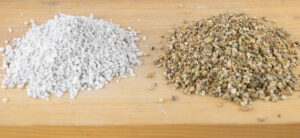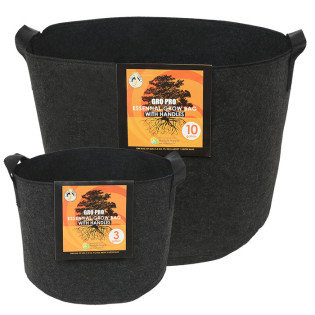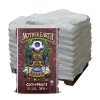
If you’ve ever found yourself trying to determine the difference between perlite and vermiculite, you’ve come to the right place.
Although these two are quite similar, there are several key differences you need to be aware of if you’re trying to provide the best possible conditions for your garden plants.
All plants require soil aeration along with plenty of water and nutrients in order to survive.
If your garden soil is lacking in these components, you may want to consider adding either vermiculite or perlite to make up for what’s missing. But which one is right for you? That’s what we’re here to answer today.
Before you rush off to buy either one of these products, familiarize yourself with the key differences between perlite vs vermiculite.
What Is Perlite?

Made out of crushed and heated volcanic rock, perlite is only created after the rock has been heated to high enough temperatures to make the material explode.
What Is Perlite Good For In The Garden?
It is often added to soil to improve drainage, making it a great addition for soilless and soil-based potting mixes.
When used correctly, perlite also helps to insulate the roots of plants from swings in temperature. A clean lightweight, and odorless material, perlite has a perfect pH for growing, of around 6.6 to 7.5.
Most gardeners use perlite by default, as it’s usually a standard including in potting soil and seed starting mixtures. However, it can also be added to soil after the fact for plants that require dry soil between watering sessions, like succulents.
It can help lighten and loosen up heavy compacted soils, as it contains pieces that only have about 6% water.
Since it has a mostly neutral pH, perlite does a great job of holding nutrients. It can hold three times its weight in water and is sterile, so you don’t have to worry about it spreading disease to your plants.
Perlite doesn’t mold or rot and generally floats to the very top of plant containers since it is so lightweight. Some people even use it as a substitute for sand.
Perlite can also be used to loosen up clay soil or if you have plants that need to dry out before you water them again.
Can You Grow Plants In Just Perlite?
Many new growers ponder simply growing their plants in a garden pot filled to the brim with perlite - can you do this?
We would advise against it for many plants, but it can certainly work for those that need to stay dry.
Your plants will be more susceptible to dehydration if you grow in 100% perlite, so opt for a soil blended with perlite instead. There are even some mixes that contain as much as 50% perlite!
What Is Vermiculite?

Vermiculite is found in many potting soil mixes but like perlite, it can be purchased by itself to add to whatever media you’re using. It is used for similar purposes to perlite: to improve soil aeration.
Technically, vermiculite is the name of a medley of hydrated laminar minerals (also known as aluminum-iron magnesium silicates) that look somewhat like mica.
The type of vermiculite you might buy for your garden is usually processed by applying large amounts of heat so that the minerals are compressed and then expanded into pellets with several layers of thin plates.
What Is Vermiculite Used For?
Vermiculite is unique because it does not mold, rot, or deteriorate in any way. It is odorless, sterile, and nontoxic to boot.
It has a neutral pH of around 7.0 and is extremely lightweight. When added to the garden by itself or used in potting soil, vermiculite increases nutrient and water retention and aerates the soil.
Your plants will be healthier and grow more vigorously as a result. Vermiculite can be used to condition, aerate, or lighten your soil. It can be used by itself or with other additions like calcium, potassium, or magnesium.

You can also use vermiculite when you are trying to propagate root cuttings. When used with peat, it can speed up seed germination, too.
Vermiculite can even help eliminate compaction in houseplants, improving aeration and reducing the frequency with which you need to water.
You can even use it in flower arrangements! All you have to do is fill a container with vermiculite, saturate with water, and pour off the extra.
It will help you keep your blooms fresh for days past the normal period of freshness.
Vermiculite is a great additive for plants that will be grown in containers as well as in composting and on lawns. It is often used in mycology, too, as it will allow you grow mushrooms with ease.
What's The Difference Between Perlite And Vermiculite?
When it comes to the difference between perlite and vermiculite, it may be helpful to first consider the similarities between the two.
Perlite vs Vermiculite - How Are They Similar?

Both can be used as lightweight sand substitutes in a soilless potting mix and both can be used to improve the texture and aeration of soil mixtures.
Both perlite and vermiculite are sterile, insect-free, disease-free, and odorless. Neither will decompose, deteriorate, or rot.
You can use both types of additions for cultivating plants as well as in seed germination, propagation, transplants, containers, and even hydroponics.
Both are also often used as carriers in pesticides, dry fertilizers, and herbicides to help improve their coverage. But you came here to learn the difference between perlite and vermiculite, so let’s take an in depth examination at that now.
The Difference Between Perlite and Vermiculite Is Moisture Retention
The key difference between the two mediums is in how each one retains water, as well as how much water each one can retain. This makes them suitable for different applications.
Technically, neither perlite nor vermiculite is superior to the other, but each one is better than the other for certain scenarios. Let’s look at some specific examples.
When To Use Vermiculite
Although perlite is found in many potting soils, vermiculite is much better when it comes to water retention. If you’re growing water-loving plants, using vermiculite is the way to go.
You may want to use vermiculite for plants like irises and forget-me-nots, as perlite dries out too quickly for these kinds of plants.
Vermiculite is also your best bet when starting seeds, as it can protect against damping-off and other fungal diseases.
It’s also a good choice if your plants are sensitive to alkalinity, as perlite can be too alkaline for some plants to tolerate.
When To Use Perlite

On the flip side, you’ll want to opt for perlite for plants that prefer to stay dry, like succulents, cacti, or rhododendron. These plants require better-draining soil, and using vermiculite could lead to root rot and kill your plants.
Perlite can also be used to boost the humidity in your soil. Perlite doesn’t hold onto water as long as vermiculite, but it does a better job of improving humidity as it releases water.
It’s best when you are rooting cuttings as it can prevent rot and it’s also the best option for planting plants that require a slightly higher pH along with lots of aeration and drainage.
Consider pH When Deciding Between Perlite vs Vermiculite
There is another key difference between the two mediums, and that difference has to do with the pH level.
Although both are close to neutral, vermiculite is considerably more so. Perlite is somewhat alkaline, so you may want to consider perlite if that’s what your plants need.
Otherwise, the two share very similar qualities - so similar, in fact, that many people believe that they are one and the same.
Both can be used as a soil amendment to aerate the soil, although perlite provides significantly more aeration than vermiculite.
Can You Substitute Vermiculite For Perlite?

Final Thoughts On Perlite vs Vermiculite
So should you use perlite or vermiculite? The decision is up to you, though both have various benefits that make them well-suited for gardeners.
You are now aware of all the key differences between perlite and vermiculite, so the rest is up to you - this choice also requires a good understanding of your grow room or garden conditions, and the type of plants you grow.
While vermiculite is best when you are starting seeds or working with water-loving plants, perlite will be better for plants that like to stay dry as well as those that prefer being grown in alkaline conditions.
Consider keeping both items on hand so you have the one you need for whatever gardening tasks demand it.
With a bit of practice, you’ll learn which garden situations require perlite, and which ones are better suited for vermiculite.



























